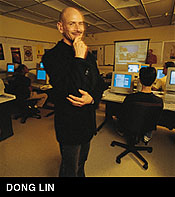![]()
Playing to Strength
by Lisa Owens-Viani
 |
Although Taylor hadn't lost his love of marine biology or his respect for scientific research, he had become increasingly concerned of the need for better, more compelling public science education. In a setting that dovetailed his interests, Taylor conducted his doctoral research on the behavior of visitors to the Steinhart Aquarium. "I was interested in discovering what people do, what they talk about and learn in museum environments, and how information can be conveyed most effectively," he explains.
After completing his studies, Taylor left the Bay Area to work in museums in New York. Prior to becoming Curator of Education with the Academy last June, he spent six years as Director of Exhibitions with the American Museum of Natural History.
Taylor saw the Academy's newly created position as both an opportunity to "come home" and "to make dynamic changes, to make the Education Department a much more prominent aspect of the Academy." One of his first goals was to encourage program managers to talk to each other. "Sam blurred the lines between the programs so that there is overlap and support among them," says Youth Programs Manager Janet Robbins. "He drew everyone under one umbrella."
Taylor also helped bring the Education and Research Divisions closer together, developing projects that maximize their joint strengths. One project still in the planning stages is a high-school curriculum to teach evolution. The Education Department would create the instructional design built on content from the Research Division. Taylor's long-term vision is to create "a generation of scientists who will be able to communicate effectively about their work. If we show that the Academy can train scientists not only to do research but also to communicate, we'll increase support for science overall."
"We needed to ask ourselves what we could do better than anyone else," says Taylor. The answer, he says, lies in the Academy's science resources: the collections, exhibits, and staff of scientists. "No other institute in the Bay Area offers the content expertise that we do," he says. "There are science museums that are wonderful places to visit, but while they may be "presenting" science, there's no science going on there." Focusing on what the Academy does best meant discarding some of its educational programs--like physics and chemistry--that others can teach better. "Our areas of expertise," says Taylor, "are biodiversity and conservation, natural history, evolution, Earth and planetary sciences, ecology, and environment."
Another plan for the Education Department is to coordinate research experience for teachers, possibly involving them in on-going field expeditions. And it won't be only teachers who will benefit. Where appropriate, future research projects will also involve high-school students. For example, they could generate maps of species distribution in the Bay Area and participate in the subsequent data collection and analysis.
Taylor expects to develop themes that can be applied across different programs. "It's really a shift in the nature of the programs and the way they're coordinated," he explains. Science educators are learning a lot more about the way children learn. The Science Framework for California Schools (published by the California Department of Education) offers guidelines--benchmarks--for the general concepts children should know at each grade level. When a teacher calls the Academy seeking a tour for fifth graders, for example, the Education staff knows what children in that grade should be learning aboutÑadaptations to environments or patterns of change over time.
"Instead of a tour based on the layout of the museum," says Taylor, "we give a tour based on those concepts, with stops in each area, using examples from Wild California, Life Through Time, African Hall, etc." The teacher then receives one of our loan kits with specimens and activities that exemplify the concepts discussed in the museum, and the outreach van follows up with programs based on what the class saw on their tour."
To further strengthen the Education Department as a resource for schoolchildren, Taylor has developed an association with the San Francisco Unified School District. Last summer, the department held a teachers-in-residence program at the Academy, in which six teachers and six docents spent two weeks exchanging ideas about K-5 science curricula and new docent tours.
"Our goal," Taylor says, "is to take the instinctive curiosity most kids have for things that run, swim, creep, and crawl and turn it into a lifetime fascination with the natural world. At Cal Academy we have the capacity to offer real education about real science, about the real thing."
Lisa Owens-Viani is a freelance environmental science writer.
![]()